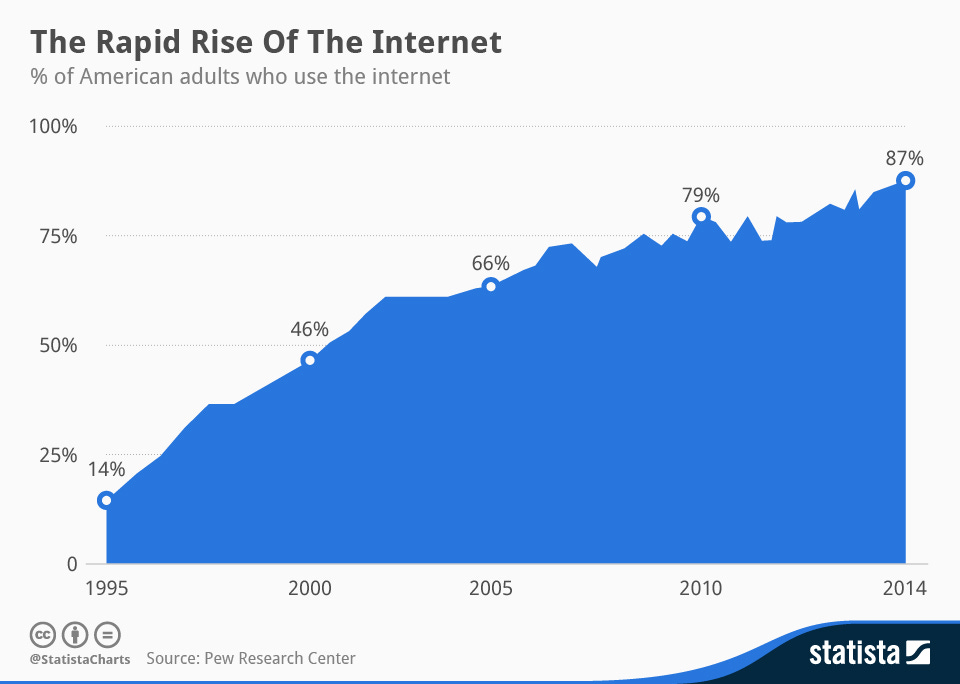If you aren’t using ChatGPT, You’re NGMI!
Not using LLMs in 2025, is like ignoring the internet in the late 90's
Not long ago, when you woke up in the morning you were flying blind. To know what you missed while you were sleeping you would have to wait until you were in front of a TV or a *gasp* physical newspaper.
This probably feels like ancient history. It’s not. In the year 2000, less than half of American adults were online. It wasn’t until 2018 that global internet usage crossed the 50 percent mark. So if you’ve been using the internet regularly for 20 years, you were an early adopter.
Even crazier to think that most of the apps, habits, and workflows we consider as the default only became mainstream in the last decade. If ride-sharing, social media, streaming, and cloud storage, were alive they still couldn’t legally drink in the US. Despite this, odds are you're reading this on your phone right now either through a browser or the Substack app.
Technology adoption works the same way as bankruptcy. Slowly at first, then suddenly all at once. This is why the internet has massively changed the way the average person lives over the past few decades; unless you are an Amish person on Rumspringa, I probably don’t need to sell you on the benefits this technology offers.
Where you might need a bit more convincing is why you should be using Large Language Models (LLMs) (click here to learn how they work). They are still early in their adoption but their impact is expected to be at least on par with the internet. This is why not using ChatGPT, Gemini, or another LLM on a daily basis, is like ignoring the web in 2000. You can continue to live your life without it, but you are sacrificing meaningful benefits that extend beyond party tricks.
You will not unlock them from Google search or the old ways of the internet. Pretending like this new technology will come and go like NFTs or AR/VR , will make you like the Boomers that never learnt how computers worked so they became reliant on broccoli haired Gen Z interns to save file as PDFs.
This is why if you are not already using LLMs on a daily basis in 2025, you are slowly making yourself unemployable and less productive. Start using LLMs or your professional life will suffer.
Find out why in this week’s article.
But first, make sure to hit the Subscribe button below to join the nearly 1,000 Subscribers that get articles like these, delivered directly to their inbox.
If this week’s article does not interest you, please check out some other recent ones:
The Current State of LLM Adoption
LLM adoption is much more widespread than you think.
In February 2025, ChatGPT had over 400 million weekly active users (WAUs), this jumped to 800 million by April. I could not find any evidence that another product has ever managed a similar feat that quickly. As a frame of reference, companies such as X/Twitter, Spotify and Snapchat have between 500 - 750 million monthly active users (MAUs). For most apps a strong ratio between WAUs to MAUs is generally between 20-25% (4:1 or 5:1), but for high engagement platforms like WhatsApp, Instagram, Youtube etc. this can range from 50-70%. Therefore it’s likely that ChatGPT’s monthly active user number is starting to approach Web2.0 consumer tech giants such as Youtube (2.5 billion MAUs), Instagram (2.4 billion) and TikTok (1.69 billion).
You might be wondering, who are these users? Is it just young people cheating on their homework? Surprisingly, according to some surveys, LLMs are seeing similar adoption rates from all age groups with the exception of 55+. ChatGPT as the first mover naturally has the highest usage rate, but the other most used products are owned by the big tech companies such as Gemini (Google), Copilot (Microsoft) and Llama (META). Only the power users are working with models from Anthropic, Perplexity or models from another pureplay LLM company.
This is not all that surprising, given how much mainstream press coverage Open AI has gotten while Google had early difficulties with Gemini. For the people using basic chatbot functions, the model performance doesn’t seem to matter as much so they are happy trusting Open AI or one of the big tech companies. Since these products have memory, they should get increasingly sticky and more useful the longer they are used.
On the other hand, those using LLMs to automate workflows or for specific niche tasks, will be more particular. Despite ChatGPTs advantage, this can fade quickly. During the early days of the internet, Mosaic then Netscape went from 100% market share to being replaced by Internet Explorer (Anti-Trust Bill’s prime) in about 4-5 years.
Speaking of the internet, it took almost a decade for nearly half of American adults to get online while relying on broadband and needing to download AOL or some other software to access it. In only about 2.5 years, ChatGPT and LLMs have already achieved a similar penetration rate with much smaller hurdles for continued adoption. Even beyond the consumer web, seemingly every company needs to come up with a response to the question “What is your AI strategy?”. The fine folks at McKinsey report 78% of organizations claim to be using AI in at least one business function, up from 72% in 2024 and 55% in 2023.
Hopefully this section was enough to convince you that LLMs are no longer a niche thing for young people afraid of social interaction. More people are using these tools every day so choosing to ignore them will put you at a disadvantage.
How LLMs can help your professional life
Unless you are very inefficient at your job, LLMs won’t help you accomplish 10X more work in half the time, as promised by some AI efficiency gurus. This does not mean they aren’t useful though.
Salespeople working in B2B SaaS make all kinds of grandiose claims their products will never be able to back up, but companies still spend trillions of dollars on these tools because they solve problems. Seeing as the average while collar professional spends about half their work week writing emails, working on memos/presentations or doing research, even slight efficiency gains can translate to major time savings.
This is why the low hanging fruit for LLM adoption starts with producing text based content. With a few prompts, you can producr great how to guides, FAQs, emails, internal memos, presentations or other time consuming internal documents. Anyone that has needed to create a playbook for new hires understands the pain of building these from scratch. Realistically, for many requests, asking ChatGPT to work on the first draft will get ~80% of the job done right there.
Although it’s usually the remaining 20% that takes the most time, it’s helpful to offload low value added tasks and focus on the difficult stuff. It’s like having an eager intern at your beck and call day and night. Except this intern doesn’t need to get paid or occasionally throw up on the CEOs shoes. This is really how you should think about these models right now. They are great for basic, low consequential stuff but as you start to use it for more important tasks, a higher level of scrutiny is needed.
I’ve been regularly testing ChatGPT over the past year for my own workflows and I can say, the product has really come a long way, but it isn’t ready to replace me (yet). When I would pose it basic cap table questions, it would hallucinate responses or confidently tell me things that were completely wrong. I would ask things such as “If we raised another $50M in a round of financing, valuing the company at x millions of dollars, what would be the new price per share?” it would return a response that would look accurate. Yet when I followed the methodology, it was immediately clear they weren’t using the correct formulas or making up new assumptions.
When I tried again recently, it did a better job but you should still definitely not trust a chatbot for something like this unless you are already an expert in this domain. The false sense of confidence it gives is deceptive, so need to know enough about a topic to spot when it makes mistakes, or you will follow bad advice and get into trouble.
Getting answers with high confidence but inconsistent accuracy is the most dangerous combination, which is why you need to ask yourself if these answers make sense and regularly audit responses.
Where are all the developers?
Outside of drafting text for white collar workers, another area that people believe is being hyper charged is software development. In recent weeks, Google and Microsoft have claimed AI writes somewhere between 20-30% of new code. They are embracing this since these companies are under pressure to accelerate new product releases with fewer developers. This is consistent with the many layoff and downsizing initiatives we’ve seen in Big Tech these past few years as they attempt to show the stock market they can continue to grow quickly with good margins.
Even early stage startups have been forced to embrace capital efficiency and operate with fewer employees now that there has been a major pull back in venture capital activity (outside of buzzy AI companies). Whether this can be attributed to efficiency gains from LLMs or not, there are now >200% fewer software development job postings on Indeed in the US compared to at the peak of early 2022. Looking back to February 2020, there are now 36% percent fewer roles compared to then.
If you ask Salesforce CEO Marc Benioff, it’s definitely because of AI tools that are boosting engineers productivity. In December 2024, Benioff said these tools were boosting engineering productivity by over 30%, prompting them to freeze hiring for software engineers. More recently, Shopify CEO Tobias Lutke issued a leaked company-wide memo emphasizing the higher use of AI in company operations. The use of AI is now a “fundamental expectation for all employees”, including Shopify execs. Lutke mandated that before requesting additional headcount, teams would have to demonstrate that they could not achieve the same outcome with AI.
What we have learned so far is that using AI well is a skill that needs to be carefully learned by… using it a lot. We also learned that, as opposed to most tools, AI acts as a multiplier. For the first time, we see the tools become 10X themselves. I’ve seen many of these people approach implausible tasks, ones we wouldn’t even have chosen to tackle before, with reflexive and brilliant usage of AI to get 100X the work done.
— Tobias Lutke April 7 2025 (You can read the full memo here)
This was directed at all employees of Shopify, not just the software developers. While Tobias was delivering this memo, another CEO was making a similar warning to his employees. Micha Kaufman, the CEO of Fiverr, believes AI is coming for jobs, including his own. It is clearly the time to start learning how these tools can help you do your job better and faster.
Conclusion
Using LLMs today feels a lot like relying on Wikipedia in the early days. For certain topics, it was a game changer (fire). For others, complete nonsense. Even if it occasionally got things wrong, it was the fastest way to get answers. With basic judgment and a few minutes to cross-check, it could save you hours.
That’s where AI is right now. Great for for low-stakes, high-volume tasks like summarizing meetings, drafting memos, or formatting. This alone can save most people hundreds of hours a year. For more critical tasks, we are not yet at the point where we can rely on autonomous agents to handle execution end to end. For the time being AI should continue to play the role of helpful assistant. So for now, continue to regard it as an eager and bright junior employee, who knows a lot of helpful facts and skills but struggles at time to be forthright when they aren’t sure about something.
Soon enough though, like a junior employee, they will be useful enough to handle things alone. This is why knowing how to prompt, while important is not the only skill you need to unlock major efficiency gains from AI. You need to be able to exercise judgement, for when you can automate things, when you can trust the answers you get and when some responses appear off. If you are sufficiently advanced in your domain and motivated, adding this will help you reach even another level.
This is why forward thinking companies are no longer sitting around a board room discussing these things conceptually, they are being used or tested in offices today. The time to start using LLMs is right now. Those that started using the internet early, gained an advantage over laggards. Don’t be a laggard. You have enough time to learn how these tools work, and not have to rely on your Zyn addicted junior. Instead you can soon have an army of autonomous agents at your disposal that can replace most of work of your entry level hires, without the attitude (or smell) and most importantly, finally create lasting and enduring shareholder value.
Thank you for reading. If you liked this article please Subscribe below. Each week I publish an article on a wide range of topics from business, books, current events or anything on my mind.












Steve Jobs once said that a big problem when the Mac was first introduced was that people didn't know how to type. Then he realized this was a problem that death would eventually solve. People not using ChatGPT seems like a similar problem.
Such a well written piece 👌
Always a fan of connecting with talented writers— let's keep in touch.